Technology has enabled us to revolutionize our society. Increasingly, how we take care of our daily responsibilities has become vastly different from one year to the other. But one thing has remained steady, the understanding that we have to do increasingly more with as little to no direct human effort.
Machines can cater to multiple purposes for a longer period of time. They can be oriented toward repetitive tasks that do not require such a high level of creativity—combining the human input and the results of machines, with their resilience and precision, results in a perfect recipe for a more prosperous future. It is the key to offering better service and quality products. In this article, we will take a closer look at the way technology can revolutionize our world.

1. Linear Actuators
Linear actuators are a type of motor that moves in a straight line. Linear actuators are most commonly used in robotics to provide an extension, or mechanical advantage, to a mechanism. They are often used to create motion in robotic arms, where they are referred to as servos. They can also be used for other medical equipment, automotive components, and industrial automation applications.
A linear actuator is made up of two parts: an electric motor and a gearbox. The gearbox converts the rotational motion of the motor into linear motion by reducing the speed at which it operates and increasing its torque. This application allows for smooth, powerful movement with minimal effort from the user.
An electrical linear actuator is generally used for heavier loads than hydraulic or pneumatic linear actuators, and they have much greater speed and acceleration capabilities. You can buy electrical linear actuator on Firgelliauto.com
An electric motor with an attached armature moves back and forth along a track. The armature is typically mounted on ball bearings or bushings to keep friction to a minimum, allowing for smooth movement along the track. A coil (or coils) is attached to the end of the armature; as electricity passes through this coil, it creates a magnetic field that attracts other magnets mounted on the inside of the track. This attraction causes the armature to move up or down along its track as needed by controlling how much electricity flows through each coil in sequence.
Linear actuators are often used in industry as an alternative to hydraulic cylinders for moving objects in a controlled manner. As technology has advanced, so have the capabilities of linear actuators, with some companies now investing in actuators capable of speeds up to 1 million cycles per minute!
2. Solar Panel Systems
Solar panels are made up of many solar cells. These cells are made up of layers of materials that convert light energy into electrical energy. Solar panel systems typically have one or more solar panels mounted onto the roof of a home or business, and they also include an inverter, which converts DC from the solar panel into AC, as well as a battery bank, which stores the energy collected by the system for later use. The most common material in solar cells is silicon. They are made out of easy-to-access and produce materials. For example, silicone can be found in the earth’s crust and is also used in integrated circuits, and as a result, its extraction ends up serving a different areal of purposes.

The basic structure of a solar cell is composed of three layers:
-
N-layer
This layer is made up of doped p-type silicon that acts as an electron donor and provides conduction electrons to the cell. It also works as a built-in PN diode to prevent current from flowing from the junction to the cell’s front side when reversing bias and acts as an anti-reflection coating for sunlight incidents on the rear side of the cell.
-
P-layer
This layer is made up of doped n-type silicon that acts as an electron acceptor and creates holes in its place (holes are like photons). It also works as an anti-reflection coating for sunlight incidents on the front side of the cell.
-
A layer
This layer is made up of glass or plastic with a transparent conductive oxide (TCO) coating on top, allowing electricity to flow through wires and onto metal contacts.

What is Clean Energy, and Why is It Important?
Clean energy is procured from natural sources in an attempt to cause no significant negative environmental effects on nature. It is an umbrella term that gathers any attempt at producing and storing energy in an as green and environmentally friendly method as possible. It usually has at its basis a process that converts natural resources or waste materials into useful forms of energy to produce electricity, heat, or transportation fuels.
Clean energy technologies include:
– solar power,
-wind power,
-geothermal power,
-hydroelectric power,
-hydrogen fuel cells,
-biodiesel and ethanol fuels, and more.
It is important to aim toward a more eco-friendly future. The consequences of climate change can already be visible throughout the world. As a result, trying to be mindful of the environment is one of the big and important steps taken in the right direction. All attempts to change the methods in which we produce energy (especially by renouncing coal-based energy) will help us alleviate the damages that are to come in the future.
In the pursuit of arriving at a better existence, clean energy represents a key issue. It is a pursuit made in the name of all people`s well-being and more prosperous life. It lessens pollution and its nocive effects on our health and is considerably cheaper to consume and easier to produce. It comes with all the benefits and none of the drawbacks.

The Bottom Line
The clean energy movement is a social movement based on the concern for the effects of fossil fuel use on the environment. “Clean” refers to any energy not derived from burning fossil fuels (oil, coal, or natural gas). Technological advancements in recent years have provided new types of clean energy sources that can replace or supplement traditional ones while reducing global warming potential (GWP).









